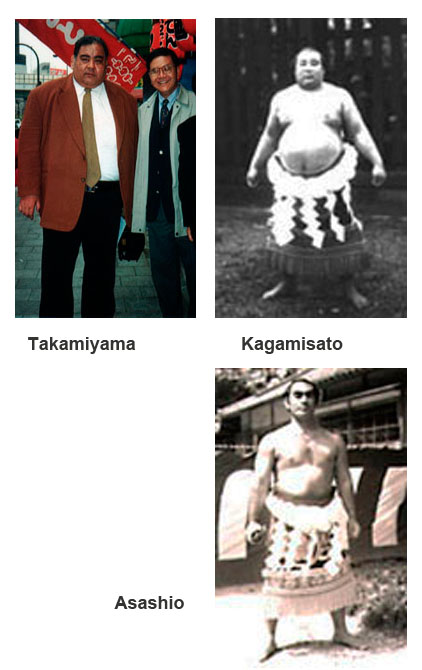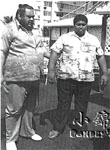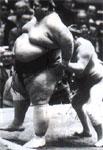
Oyakata - master. The suffix to the name taken by a retired rikishi. The retirement name is different than the name used by the rikishi during his fighting days.
Many people upon seeing a photo of sumo or of a rikishi see only a bunch of fat men dressed in loincloths performing some strange ritual, or if they see an actual bout, wonder how a sumo match could be interesting when the match may last only a few seconds after a waiting around period of about 4 minutes. Granted, it does take some time to understand sumo's history, rituals, and culture to begin appreciating the beautiful sport and culture that it is, and how sumo grows on you.


The left image (unavailable) was taken at the 1996 Haru (Spring) Basho in Osaka. The big fellow is the former Takamiyama, who was Jesse Kahuelua from Hawaii, the first non-Japanese rikishi. Takamiyama stands about 6 foot 5 inches tall (1.96 meters), and at his peak, was about 390 pounds (177 kgs). Takamiyama is now retired and has his own heya. Takamiyama reached the rank of sekiwake and did not make yokozuna. His retirement name is Azumazeki Oyakata.
The center image is of Takamiyama and one of his imports, also from Hawaii, who became Konishiki, possibly the heaviest rikishi ever. Konishiki is also now retired, and reached the rank of ozeki, but did not make it to yokozuna. Konishiki's name was Salevaa Atisanoe.
The right image shows a match in the 1997 Natsu (Summer) Basho between the then largest rikishi and the smallest. Konishiki weighed in at 274 kgs (604 lbs) vs the 99 kgs (218 lbs) Mainoumi, who was also only 1.71 meters (5 foot 7 inches) tall. In order to make the minimum height requirement for a rikishi, Mainoumi had silicon injected into the top of his skull to add an inch of height.
In the late 1950's, there was a time when sumo had five yokozunas competing. It was an memorable period of great yokozunas. Those five are shown on the right panel.

Yokozuna Chiyonoyama, 1.90 meters, 122 kgs, won lost record 366 - 149.





These five yokozunas, from left to right, are:
Kagamisato - with one of the most beautifully round stomach; it was a perfect sphere. He stood 1.74 meters tall, weighed 161 kgs, and won a total of 4 yusho (championships). He was a rikishi from 1941 - 1958, and was elevated to yokozuna in 1953.
Yoshibayama - had stature, height, and beauty as a rikishi. Though he won only one yusho, he was a popular yokozuna. 1.79 meters, 132 kgs. Rikishi from 1938 - 1958, and became yokozuna in 1954.
Asashio - was referred to as the hirsute and handsome yokozuna. He won 5 yusho, 1.88 meters, 135 kgs, and was a rikishi from 1948 - 1962. Yokozuna in 1959.
Wakanohana - was an agile wrestler who relied on technique and skill to win. He won a total of 10 yusho, 1.79 meters tall, 105 kgs, and was a rikishi from 1946 - 1962, and became yokozuna in 1958. He is now known as Futagoyama Oyakata and is senior master of the Futagoyama Beya, or stable.
Tochinishiki - was a master tactician, combining size, strength, and skill as a wrestler. He won 10 yusho, 1.77 meters tall, 132 kgs, and was a rikishi from 1938 - 1960. Yokozuna in 1954.
Overlapping this period of these great yokozunas was Chiyonoyama, who had won a total of 6 yusho, the last one being in 1957. He retired in 1959, but is generally regarded as being of an earlier era than the above five yokozunas.
Kagamisato vs Tochinishiki - 376 Kbytes
Yoshibayama va Kagamisato - 492 Kbytes
Asashio vs Wakanohana - 1461 Kbytes
The second movie is a bout between Yoshibayama and Kagamisato on the 15th day of the 1956 Aki Basho, which Kagamisato won to take the yusho (tournament championship) with a 14 -1 won-lost record. Kagamisato won by hatakikomi, slapping the opponent down, after trying an uwatenage, overarm throw.
The third bout is between Asashio and Wakanohana on the 15th day of the 1958 November Basho. Asashio won by yorikiri (frontal push out) after a long match to win the yusho with a 14 - 1 won-lost record.